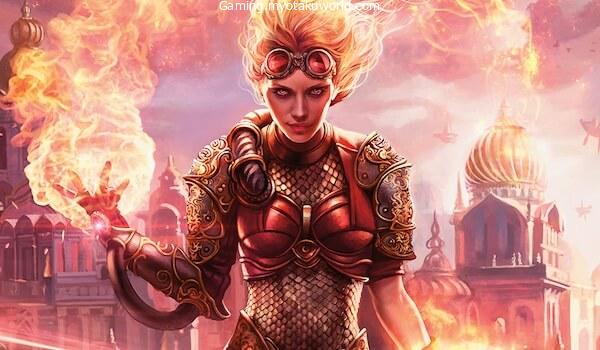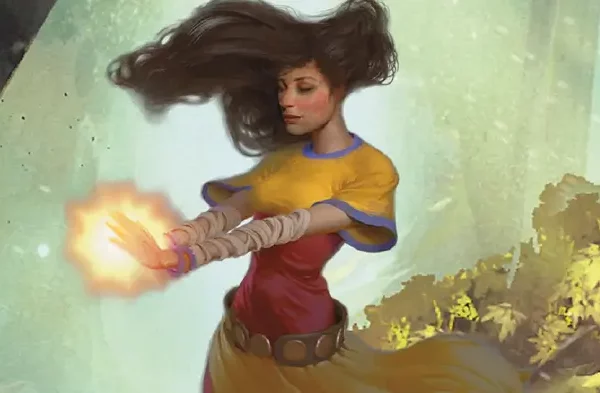In D&D, the Genasi are a fun race that fits the story.
Each of the four Elemental Planes is represented by one of the four Genasi sub-races.
They are also the closest you can get in 5e to playing an elemental.
This article talks about the Genasi, their subraces, their traits, and which classes are good for them.
Let’s start with what the Genasi in D&D are.
What is a Genasi in D&D 5e?
Genasi are a playable race in D&D 5e.
They are related to elementals, especially genies, so they have themes related to those things.
Genasi are a race that you can choose when making your player character.
So, they have their own sub-races and racial traits, which I’ll talk about in a bit.
Some players say that Genasi are half-elementals.
Genasi are usually born when a human and an elemental (usually a genie) have a child.
A Genasi gets the elemental traits from his or her parents, but the child usually looks more human.
What Book Are Genasi In 5e?
In D&D 5e, the Elemental Evil Player’s Companion is where Genasi came from.
The Princes of the Apocalypse(PotA) adventure module will use this free resource.
Since then, the Genasi race has not been a choice in any books or other materials.
Since PotA was mostly about the four Elemental Planes, it makes sense that Genasi haven’t been in other source zero books, I guess.
Wizards of the Coast made Goliath a playable race in Volo’s Guide to Monsters, which is why I don’t like this.
In the Elemental Evil Player’s Companion, Goliath also made their first appearance.
Why not the Genasi, then?
But neither the Aarakocra nor the Deep Gnomes have come back like the Genasi.
It’s clear which of those races was the most popular.
The Genasi Sub-Races
In D&D 5e, Genasi are divided into four subraces: Air Genasi, Earth Genasi, Fire Genasi, and Water Genasi.
One for each of the Forgotten Realms’ Elemental Planes.
Each of the four main Elemental Planes is represented by one of the sub-races of the Genasi.
So, each one has its own taste and characteristics.
Even though they look different depending on where they came from, all Genasi have the same vaguely human-like features.
If it weren’t for their strange skin, eye, and hair colour and other effects in the environment, like a constant breeze or the smell of brimstone, they would look and act like any other human or humanoid race.
Still, any Genasi, no matter what sub-race they are, may look more human-like than not, with only small hints of their elemental ancestry.
Also, a genasi is usually born when a human and one of the elemental genies (djinn, dao, efreet, or married) have a child.
But they might be able to find their elemental ancestors further back in their family tree.
Or, they could be born near a portal to one of the Elemental Planes, where they are exposed to strong elemental forces.
Air Genasi
Air Genasi are a part of the Air Elemental Plane.
Most of the time, they can trace their roots back to djinn, which are air genies.
Like the wind, Air Genasi tend to be carefree, but they can get angry as quickly as the weather changes.
Air Genasi might have hair, eyes, and skin that are all shades of sky blue.
Most of the time, they come with a soft breeze that gently moves their hair and clothes.
Earth Genasi
The Earth Genasi stand for the Earth Elemental Plane.
They are made when a humanoid and a creature made of earth have a child together.
Most of the time, this means mating with the dao, which is an earth-based genie.
Since they come from the earth element, Earth Genasi tend to be slow and careful.
And they are stronger and can do some things with stone and earth.
A planet Genasi has as many different looks as there are kinds of natural stone in the world.
Most of the time, their skin is dark, like black, grey, or brown.
But their skin can be rough and look like gravel, smooth and metallic, or even shiny like a gem.
Fire Genasi
Fire Genasi are part of the Fire Elemental Plane.
They are the offspring of a humanoid and a fire elemental creature, usually an efreet.
The Fire Genasi are usually bold and quick to anger, and they tend to be louder people.
Most Fire Genasi look like their family tree, which is made of flames.
Their skin color ranges from ash grey to reddish brown to even black.
Most Fire Genasi feel like they have a fever, which is an interesting thing about them.
Their hair could just look red, or it could be made of fire.
Water Genasi
Water Genasi are part of the Water Elemental Plane.
When a married or other water-element creature raises a child with a humanoid creature, the child may take on some of their elemental traits.
Water Genasi are usually drawn to the freedom and a desire to go places, which makes them natural adventurers.
The look of a Water Genasi is, of course, based on water.
Their skin might be blue or green and always feel damp.
Their eyes might be blue-black and a little bit bigger than a normal human’s.
And their hair might look like it’s floating in water.
Genasi 5e Traits
The basic traits of a Genasi don’t really stand out.
Of course, they also get the usual Ability Score bonus, a base movement speed, and a couple of languages.
But that’s pretty much it.
From the Elemental Evil Player’s Companion, here are the main characteristics of a Genasi:
- Scores on abilities go up.
- Your score for Constitution goes up by 2.
- The size of you is Medium.
- Your base walking speed is 30 feet.
- You can read and write in both Primordial and Common language.
On the Genasi race page of DnD Beyond, you can also find all of the traits for free.
You can, of course, ignore the Ability Score Increase traits if you’re using Tasha’s Cauldron of Everything.
But I’m leaving them in case your table doesn’t use that optional rule.
Now, since the Genasi race has different sub-races, each one has its own traits, just like any other race.
Here, the Genasi’s race starts to show itself.
So, let’s go over each one’s unique traits.
Air Genasi Traits
The traits of Air Genasi show how much they like the wind and the open sky.
These Genasi are the ones with the most of the skills.
That’s about as useful as they get, though.
Some players refer to the Air Genasi’s traits as “ribbon abilities”,
Basically, they are the traits that are mostly for flavour and might never come up in your game.
Before I say much more, let’s look at what the Air Genasi are like.
- Scores on abilities go up.
- Unending Breath: Your Dexterity score goes up by 1.
- If you’re not hurt, you can hold your breath for as long as you want.
- Come together with the Wind.
- The levitate spell can be used once per long rest.
I meant the trait called “Unending Breath.”
Even so, I did use it to keep my Air Genasi Ranger, Gustav, from getting poisoned in one of the adventures in Tales from the Yawning Portal.
But I don’t see that happening very often.
Maybe if a spell like “Stinking Cloud” affects you, but that’s still a pretty narrow case.
Air Genasi can make decent Thieves, Monks, Ranger-based Fighters, and Ranger-based Fighters with dex.
Earth Genasi Traits
The traits of Earth Genasi show their connection to stone.
Since their Strength Ability Score goes up, this Genasi sub-race is the most physically powerful of its kind.
But they can also move around a lot on land.
Here are the qualities of an Earth Genasi:
- Scores on abilities go up.
- Earth Walk adds 1 to your Strength score.
- You don’t care about rough land made of earth or stone.
- Combine Stone: Once per long rest, you can use the pass without trace spell.
The spell Pass Without Trace is very powerful.
So, even if your character isn’t sneaky, you still have a great Stealth trait.
Also, if you’re a front-line fighter, it’s great to be able to ignore difficult terrain.
In 5e, Earth Genasi works well with classes that act as tanks.
There are Barbarians, Fighters, and Paladins among these classes.
But you can choose any character based on Strength or any frontline fighting class.
Fire Genasi Traits
Fire Genasi traits have to do with fire and light.
In all honesty, it seems like the Fire Genasi don’t get as much as their Air and Earth cousins.
- Scores on abilities go up.
- Your score for Intelligence goes up by 1.
- Darkvision: You can see up to 60 feet away in dim light as well as in bright light, and in the dark as well as in dim light.
- Fire Resistance: You resist fire damage.
- Get to the fire: When you reach 3rd level, you know the produce flame cantrip and can use the burning hands spell once per long rest.
Fire usually shows up at some point in most adventures, so the Fire Resistance trait is great.
And the ability to see in the dark is always a plus for any player character.
With their Intelligence bonus, Fire Genasi do well as Artificers and Wizards.
Or, if you like fighting, Eldritch Knight Fighters, Psy Warrior Fighters (TCoE), and Arcane Trickster Rogues are all great choices because they use Intelligence in some way.
Water Genasi Traits
Water Genasi have traits that give them some control over water and help them stay alive in it.
The most sub-race traits are given to them than to any other Genasi.
- Upgraded Skills: Your score for Wisdom goes up by 1.
- Acid Resistance: You resist acid damage.
- Amphibious: Both air and water can be breathed in.
- Swim: You can swim 30 feet per minute.
Tell the Wave to come.
When you reach 3rd level, you know the shape water cantrip and can use the create or destroy water spell once per long rest.
Now, are these Genasi sub-races as useful as the others?
Yes, in some cases.
They are resistant to damage, can breathe underwater, move at a different speed, and have some natural spellcasting skills.
Along with the usual bonus for Ability Score.
The only bad thing is that all of these traits have something to do with water.
So, you’ll only need them if your campaign has a lot of water or if your adventure takes you near a water source.
Water Genasi does well in any class that uses Wisdom as a core Ability Score.
So, they are great Clerics, Druids, Monks, and Rangers.
Which Classes Are Good for Genasi?

Now that you know the basics about the Genasi in 5e, let’s look at the classes they can choose from.
Like any other playable race in D&D, Genasi are better at some classes than others.
Most of the time, this means that their Ability Score bonus should match the core stat of the class.
But Genasi’s best classes are also affected by his or her more specific racial traits.
If you play Tasha’s Cauldron of Everything with the optional Ability Score rules, Genasi can be any character class.
I’m mostly looking at their Ability Score bonuses, but the other traits do have some effect.
But TCoE has an optional rule that lets you change the Ability Score bonus of one race for that of another.
So, just remember that TCoE has nothing to do with the best classes for Genasi.
So, let’s talk about the best D&D 5e classes for a Genasi.
Good Classes for Genasi in D&D 5e
In 5e, the best classes for Genasi take into account their Ability Score Increases.
Since the Genasi have four subraces, you can choose from a lot of good classes.
Now, the other sub-race traits of the Genasi don’t really lean toward any one class.
Because of this, you have a lot of freedom to choose what role you want to play in your class or party.
Here is a list of Genasi’s best D&D classes:
Artificer
Fire Genasi are good choices for the Artificer because they have a bonus to Intelligence.
The Earth, Fire, and Water Genasi are the best choices for an Artificer who wants to add more spells to their list.
But remember that for the Genasi’s natural spells, you use your Constitution modifier.
Barbarian
With their Strength and Constitution bonuses, Earth Genasi are a good race for Barbarians.
Also, if you don’t care about stone-based difficult terrain, you might end up in situations where melee combat is easier.
Cleric
If you want to play a Genasi Cleric, you should choose the Water sub-race.
Their Wisdom bonus helps you cast spells as a Cleric, and their damage resistance gives you a little more chance to stay alive in certain situations.
Still, Earth Genasi is a good choice for Clerics who want to be more martial and have a little more stealth with passing without trace.
Druid
If you want to play a Druid in 5e, Water Genasi is a good choice.
Getting a boost to your Wisdom is great for a Druid’s ability to cast spells, and being able to take less damage from acid is useful in certain situations.
Also, since you take on the physical traits of your beast form when you use Wild Shape, your damage resistance probably won’t work.
Fighter
Since Earth Genasi is fighters, they make great Fighters.
Their bonuses to Strength and Constitution are great for playing a Fighter in the front line.
But Air Genasi are a good choice if you want a fighter with more of a focus on Dexterity (especially for using levitate to rise above the battlefield).
Fire Genasi also work well for the Eldrith Knight and Psy Warrior (TCoE) classes, whose spells and abilities are based on Intelligence.
Monk
Genasi can be a monk.
With the Dexterity boost, the Air Genasi is a good choice, but their natural spellcasting (i.e., levitate) doesn’t really work for a melee-focused class.
The Wisdom bonus of Water Genasi works well, and their other racial traits give them a bit more than Air Genasi.
Paladin
Since they get extra Strength and Constitution, Earth Genasi make good Paladins.
Like other martial classes, ignoring stone-based difficult terrain is great for getting into melee with hostile creatures.
A lower Dexterity score is made up for “pass without trace.”
Still, if you play a Dexterity Paladin, Air Genasi can work just as well.
Ranger
Because they have a bonus to Dexterity, Air Genasi are good for Rangers.
But if you’re playing a Ranger with a gun, levitate can help you get away from enemies who are close up.
Earth Genasi are good for melee-focused Rangers, especially since the free pass without trace helps make up for the Ranger’s not-so-great spellcasting.
And Water Genasi work to help your Ranger cast spells better.
Rogue
If you want to play a Rogue, Air Genasi are probably your best bet.
Their bonus to Dexterity is good for Rogues, and levitate can be useful in some situations.
With their Intelligence bonus, Fire Genasi is also not a bad choice for Arcane Tricksters.
Wizard
Fire Genasi are the best choice if you want to be a Wizard.
Their bonus to intelligence is a great way to help you cast spells.
And the spells they already know make room for your Wizard spells.
Remember that your Constitution score is your Genasi spellcasting ability score.
Now that you know some of the best classes for Genasi in 5e, let’s look at some of the worst ones.
Bad Classes for Genasi in D&D 5e
The three classes that aren’t good for Genasi are the Bard, the Sorcerer, and the Warlock.
All of these classes focus on the Charisma Ability Score.
Since Genasi get no bonus to Charisma, these classes can’t cast spells as well as they could.
Still, each of these has its own pros and cons when you play as a Genasi.
Bard
If you focus more on the martial subclasses, a Genasi Bard could work.
With an air or earth Genasi, the College of Valor and the College of Swords (Xanathar’s Guide to Everything) could work.
Sorcerer
Genasi Sorcerers really don’t have any good choices.
You don’t have a lot of choices as a Sorcerer because you don’t have a Charisma bonus or any kind of martial Sorcerer subclass.
Warlock
In Xanathar’s Guide to Everything, the Hexblade Warlock is a good choice for Air and Earth Genasi.
But your spells and class abilities get worse because your Charisma isn’t as high.
FAQs
How Do You Pronounce Genasi?
On the DnD Beyond page for Genasi, it says that the name is pronounced “jeh-NAH-see.”
What Language Do Genasi Speak?
In D&D 5e, Genasi speak Common and Primordial. If you’re playing with Tasha’s Cauldron of Everything’s optional player character rules, you can switch them out for any other language your DM lets you.
How Tall Are Genasi?
In 5e, Genasi are about the same height as people. So they are usually between five and six feet tall.
How Long Do Genasi Live?
In D&D 5e, the Genasi age at about the same rate as people. But they live longer and can live up to 120 years.
Can Genasi Look Human?
In 5e, Genasi often look vaguely human, but they have some weird things about them, like strange skin tones or small magical effects around them. Still, a Genasi might look more human, with only small signs of their elemental heritage.
Are Genasi Elementals?
In D&D 5e, Genasi are only people. That means they are not elements.
Final Thoughts
I like the Genasi in D&D as a whole.
But, especially the Air Genasi, they don’t feel like they have enough power.
Still, a playable race can only affect a character’s quality so much.
Genasi are the closest thing to elemental player characters that we have in 5e, but they aren’t elementals.
Even though a few of the sub-races seem to have had more thought put into them, they all have traits that fit with their themes.
Genasi are good at most of D&D 5e’s classes because they have many different sub-races.
I always like to remind people at the end of these posts to play the character they want to play.
You can be a Fire Genasi Bard if you want to.
You can play a Genasi Warlock with a Genie Patron because one of their parents is a Genie Patron.
That sounds really great.
Don’t let anyone tell you that you can’t play those characters because they’re “not optimized.”
One of my favourite characters was an Air Genasi Ranger named Gustav, or Gust for short.
He was around for a long time, too.
Let me tell you, the spell “Levitate” doesn’t seem like much until you need it.
And it feels good to hold your breath forever to get out of a dark room with poison gas.
Have you ever played a Genasi, or are you currently playing one?
Leave a comment below, and we’ll tell each other about our adventures.









